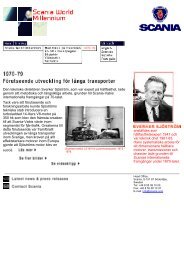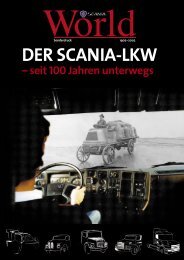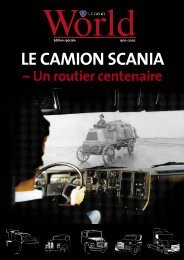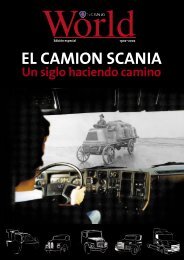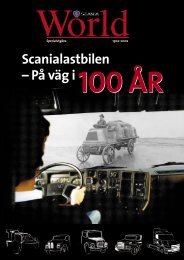Scania World Millennium
Scania World Millennium
Scania World Millennium
You also want an ePaper? Increase the reach of your titles
YUMPU automatically turns print PDFs into web optimized ePapers that Google loves.
During the 1980s, modularisation<br />
made its definitive breakthrough.<br />
When the new Program <strong>Scania</strong> truck<br />
range was introduced in 1980-81, it<br />
was a product based entirely on<br />
modular production. Not only<br />
<strong>Scania</strong>'s engines and gearboxes but<br />
also its axles, frames and cabs were<br />
now modularised. The father of this<br />
product range was Stic Ericsson, a<br />
far-sighted engineer who headed its<br />
modular development work, starting<br />
<strong>Scania</strong> GPRT-series from 1981.<br />
in 1974. He was also the man behind<br />
the successful <strong>Scania</strong> 3-series of<br />
trucks, launched in 1987-88. In this series, <strong>Scania</strong> went a step further by<br />
introducing made-to-measure trucks based on customer orders. Using<br />
computer-aided design, all components were tailored to customer wishes and<br />
then brought together at the chassis workshop a few weeks later.<br />
was re-employed at <strong>Scania</strong> in<br />
1974 to lead the development<br />
of the new modular Program<br />
<strong>Scania</strong>. He was technical<br />
director between 1983-90 and<br />
during that time initiated<br />
intensive technical<br />
development on several<br />
fronts.<br />
Head Office:<br />
<strong>Scania</strong>, S-151 87 Södertälje,<br />
Sweden<br />
Tel: +46 8 55 38 10 00<br />
Fax: +46 8 55 38 10 37<br />
E-mail: info@scania.com
During the 1980s, <strong>Scania</strong> introduced two new modular truck ranges.<br />
Intensive technical development on many fronts also enabled the<br />
company to manufacture "made-to-measure" trucks based on<br />
customer orders.<br />
In 1980-81, <strong>Scania</strong> introduced the new Program <strong>Scania</strong> range of trucks.<br />
Encompassing trucks in the 16-36 tonne gross weight range, it was based<br />
on far-reaching modularisation not only of engines, gearboxes, propeller<br />
shafts and final gears, but also chassis components such as axles, frames<br />
and especially cabs. This enabled <strong>Scania</strong> to respond to market demands<br />
for solutions tailored to different transport needs, while satisfying demands<br />
for more economical production. Using a limited number of components,<br />
<strong>Scania</strong> could build an almost unlimited number of truck variants.<br />
<strong>Scania</strong> T112 E6x2 tipper and <strong>Scania</strong> T112 E6x4<br />
dumper in 1981.<br />
The new range had been preceded by methodical development work. As<br />
early as 1974, <strong>Scania</strong>'s long-term planning department had been assigned<br />
to study existing and future demands in various market segments. Once<br />
these had been analysed, it was possible to begin technical development,<br />
which was crucial to <strong>Scania</strong>'s continued competitiveness. The man in<br />
charge was a far-sighted engineer, Stig Ericsson, who assumed a position<br />
as head of chassis design and production.<br />
<strong>Scania</strong> pursued its modular development<br />
work consistently and systematically. In<br />
disciplined fashion, pre-production<br />
engineers accepted the constraints that the<br />
modular philosophy obviously imposed on<br />
their freedom. Their work was richly<br />
rewarded, as the new cab range in<br />
particular demonstrated. In principle, three<br />
different cab families were replaced by a<br />
single modular family. As a result,<br />
customers were offered greater variety<br />
while the number of items in the full cab<br />
<strong>Scania</strong> R92 Brasil in the 1980s.<br />
range shrank by 70 percent. The number<br />
of sheet metal parts, which required<br />
expensive investments in press tools, was<br />
reduced to a minimum and average working hours per cab fell by about 30 percent.<br />
The new Program <strong>Scania</strong> range marked the return of efficient modular thinking as<br />
one of the cornerstones of <strong>Scania</strong>'s corporate philosophy. Due to thorough<br />
modularisation, <strong>Scania</strong> trucks were characterised by high quality and cost-effective
production. This paved the way for comparatively high margins and the best<br />
profitability in the industry.<br />
When <strong>Scania</strong>'s 2-series was introduced, Stig Ericsson assumed the post of technical<br />
director of <strong>Scania</strong>. He became the head of all technical departments, which he alone<br />
represented in <strong>Scania</strong> Division management. He had extensive technical know-how.<br />
His vision encompassed not only product development, but also shorter production<br />
lead times, computer-aided design, flexible production automation, shorter<br />
order-to-delivery times, reduction of tied-up capital in stores and inventories and<br />
global sourcing. Under his leadership, <strong>Scania</strong> pursued intensive technical<br />
development on many fronts throughout the 1980s.<br />
In 1987-88, <strong>Scania</strong> introduced the 3-series, awarded the "Truck of the Year" award<br />
in 1989. In the 3-series, <strong>Scania</strong> further refined its modular thinking. The company<br />
was able to manufacture "made-to-measure" trucks based on customer orders.<br />
In a dialogue with the dealer, each customer could specify individual demands.<br />
Together, they were able to design a truck - component by component and part by<br />
part. The result was a "made-to-measure" truck, with a unique combination of<br />
components and equipment. Computers broke down this unique truck order into its<br />
constituent elements. This immediately resulted in sub-orders for frame members,<br />
axles, a cab, transmissions and an engine from component manufacturers. These<br />
would be assembled a few weeks later on a predetermined date at one of <strong>Scania</strong>'s<br />
chassis workshops.<br />
All 3-series components had been designed with the aid of computers,<br />
which also generated other information, such as data on how each<br />
component should be attached - whether to drill holes in the truck<br />
frame, what kinds of bolts, nuts and washers were needed and so<br />
forth.<br />
Frame designs vary greatly from one truck to another, so a frame<br />
cannot be manufactured before the truck has been specified. There<br />
are variations in the dimensions of the various members, but above all,<br />
in the hundreds of holes to be drilled in the ribs and flanges of the<br />
frames. The number, placement and sizes of these holes depend on<br />
the type of truck, engine, gearbox, cab, axles, wheelbase and<br />
equipment.<br />
In Södertälje, a highly automated hole-drilling line was completed as<br />
early as 1985. It was a 170-metre-long, flexible manufacturing system<br />
that could work entirely unmanned for hours at a time. Frame member<br />
elements arrived from Luleå a day or so before the holes were to be<br />
drilled. When it was time to start manufacturing the frame, an<br />
automated pick crane fetched the proper side member at a "pick<br />
centre". Computers automatically translated the order specification into<br />
a unique set of holes to be drilled in the members.<br />
<strong>Scania</strong> T112 in Argentina.<br />
Put simply, this meant that if a customer had ordered a given piece of<br />
equipment, the machinery would automatically drill suitable holes for it<br />
in the frame members. After sand-blasting and painting, the frame<br />
members continued into the assembly shop, where the other truck<br />
components awaited it.<br />
Head Office:<br />
<strong>Scania</strong>, S-151 87 Södertälje,<br />
Sweden<br />
Tel: +46 8 55 38 10 00<br />
Fax: +46 8 55 38 10 37<br />
E-mail: info@scania.com



